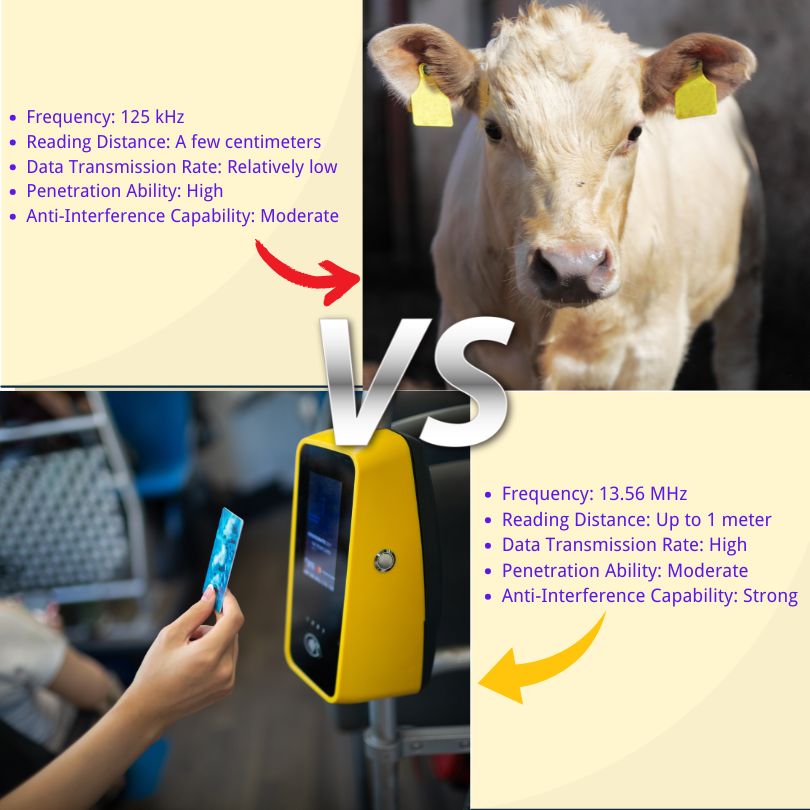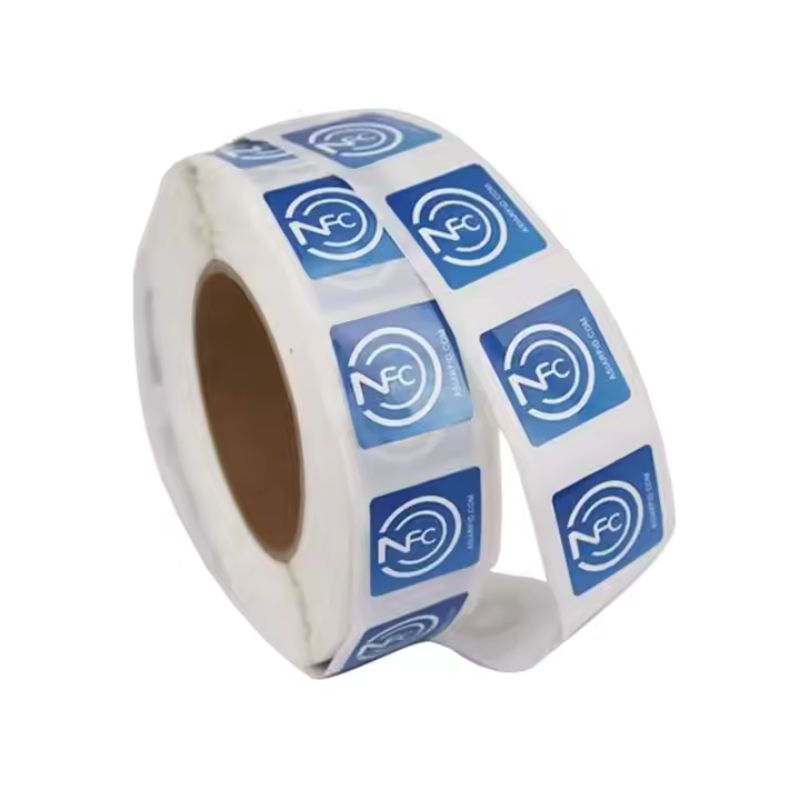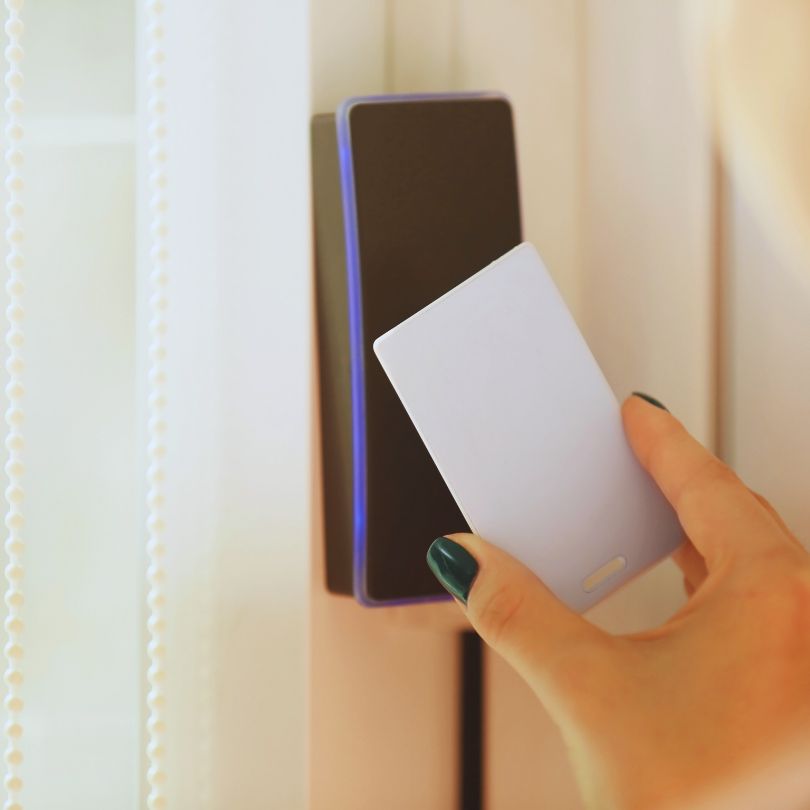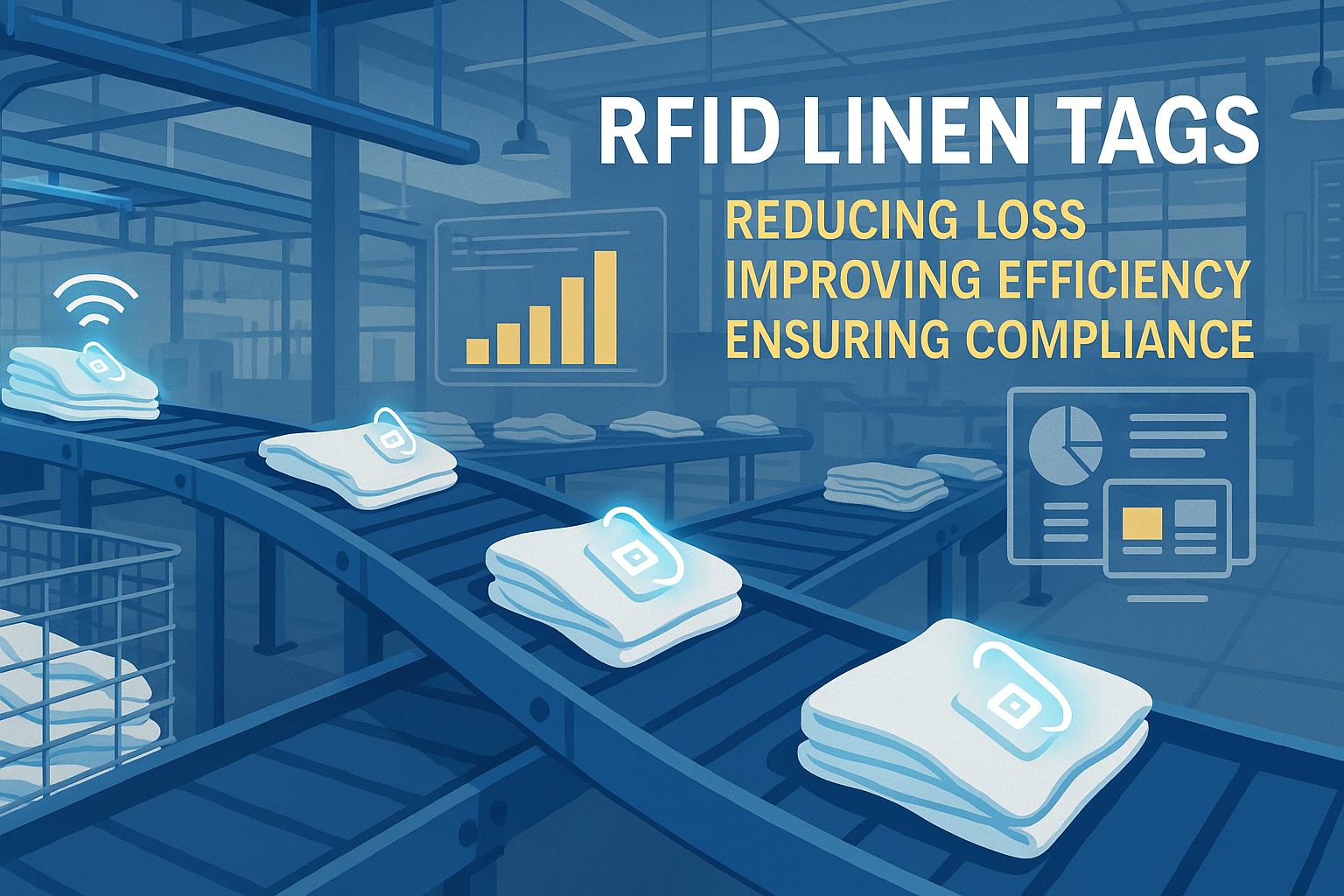
13,56 MHz ja 125 kHz RFID-tunnisteiden erojen ymmärtäminen
Sisällysluettelo
13,56 MHz ja 125 kHz RFID-tunnisteiden erojen ymmärtäminen

RFID-taajuuden todellinen merkitys (LF vs. HF)
RFID-järjestelmät käyttävät radioaaltoja viestintään tagit ja lukijat. Niiden käyttötiheys vaikuttaa siihen, kuinka kauas ne voivat lukea, kuinka nopeasti ne lähettävät dataa, kuinka ne käyttäytyvät metallin tai veden lähellä ja minkälaista dataa ne voivat tallentaa.
Tässä on ydinajatus:
Matalan taajuuden (LF) = 125 kHz RFID-tunnisteet
- Lyhyt kantama
- Hitaampi tiedonsiirtonopeus
- Erinomainen suorituskyky metallin tai nesteiden lähellä
- Yksinkertainen, kestävä ja edullinen
Korkeataajuus (HF) = 13,56 MHz RFID-tunnisteet - Pidempi kantama
- Nopeampi tiedonsiirtonopeus
- Edistyneempi tietoturva
- Yhteensopiva NFC:n ja älypuhelimien kanssa
13,56 MHz vs. 125 kHz
| Ominaisuus | 13,56 MHz RFID-tunnisteet | 125 kHz RFID-tunnisteet |
|---|---|---|
| Taajuus | 13,56 MHz (HF) | 125 kHz (LF) |
| Lue Range | Jopa 1 metri | 2-10 cm |
| Tiedonsiirtonopeus | Korkea | Matala |
| Suorituskyky metallin lähellä | Kohtalainen | Vahva |
| Turvallisuus | Tukee salausta, keskinäistä todennusta | Perus, yleensä ei salausta |
| NFC / älypuhelintuki | Kyllä | Ei |
| Maksaa | Korkeampi | Alentaa |

Turvallisuus: Onko yksi taajuus turvallisempi?
125 kHz RFID-tunnisteet käytetään usein vanhemmissa järjestelmissä, ja niissä käytetään tyypillisesti kiinteitä yksilöllisiä tunnisteita ilman salausta. Siksi ne on helppo kloonata tavallisilla laitteilla. Ne sopivat hyvin matalan riskin järjestelmiin, mutta eivät täytä nykyaikaisia turvallisuusstandardeja.
13,56 MHz:n RFID-tunnisteet, erityisesti MIFARE- tai DESFire-kortit, tukevat:
- Salaus
- Keskinäinen todennus
- Turvallinen muistin tallennus
- Useita sovelluksia yhdellä kortilla
Pohjimmiltaan: - Käytä 125 kHz:n RFID-tunnisteita, kun turvallisuusvaatimukset ovat alhaiset (kuten kaappien avaimet, kellokortit).
- Valitse 13,56 MHz kulunvalvontaan, maksuihin tai mihin tahansa henkilötietoja tallentavaan järjestelmään.
NFC ja älypuhelinten yhteensopivuus
Jos projektisi liittyy puhelimiin, 125 kHz:n RFID-tunnisteet eivät toimi.
Vain 13,56 MHz RFID-tunnisteet tukee NFC-tekniikkaa (Near Field Communication), jota käytetään mobiilimaksamisessa, sisäänkirjautumisessa ja tap-to-pair-ominaisuuksissa.
Useimmat älypuhelimet voivat lukea ja kirjoittaa NFC-tunnisteita 13,56 MHz:n taajuudella, mikä tekee tästä taajuudesta ihanteellisen seuraaviin käyttötarkoituksiin:
- Digitaaliset liput
- Tapahtumien sisäänkirjautumiset
- Älykkäät julisteet
- Kanta-asiakaskortit
- Kontaktiton mobiili-ID
Jos älypuhelimen tuki on tärkeää, 13,56 MHz on ainoa vaihtoehto.
Todelliset käyttötapaukset toimialoittain
| Teollisuus / Sovellus | 125 kHz RFID-tunnisteet | 13,56 MHz RFID-tunnisteet |
|---|---|---|
| Kulunvalvonta | Peruslukitusjärjestelmät, vanhat ovet | Turvalliset tunnistetiedot, modernit henkilökortit |
| Julkinen liikenne / Lippujen myynti | Ei tuettu | MIFARE/NFC-pohjaiset matkakortit |
| Eläinten seuranta | Laajasti käytetty kudosten läpäisykyvyn ansiosta | Harvinainen |
| Teollinen automaatio | Luotettava metallin/nesteen lähellä, kestävä käyttö | Harvinaisempi ankarissa olosuhteissa |
| Terveydenhuolto | Ei ihanteellinen potilaiden tai lääkkeiden seurantaan | Parempi turvallinen tunnistaminen ja omaisuuden merkitseminen |
| Kirjastot / Arkistot | Harvinainen | Suosittu kirjojen seurantaan ja lainaukseen |
| Markkinointi / Tapahtumat | Ei sovelleta | Älykkäät julisteet, NFC-tapahtumapassit |
| Ajoneuvon varkaudenesto | Avaimiin/sytytyslukkoihin upotetut 125 kHz:n RFID-tunnisteet | Ei käytetty |

Kuinka valita projektillesi 13,56 MHz:n ja 125 kHz:n välillä
Käytä tätä tarkistuslistaa päätöksesi tekemisen helpottamiseksi:
1. Turvallisuustaso
- Tarvitsetko salausta tai suojattua pääsyä? → Valitse 13,56 MHz
- Matalan riskin seuranta tai perus-ID? → 125 kHz voi riittää.
2. Ympäristö
- Voimakas häiriö, metalli tai neste lähellä? → 125 kHz toimii paremmin
- Puhdas toimisto vai sisätila? → Kumpikin sopii; valitse ominaisuuksien perusteella.
3. Älypuhelimen integrointi
- Haluatko käyttäjien skannaavan puhelimilla? → Vain 13,56 MHz tukee tätä.
4. Talousarvio
- 125 kHz:n tunnisteet ovat edullisempia hankintahetkellä.
- Mutta 13,56 MHz tarjoaa enemmän pitkäaikaista arvoa, jos tarvitset ominaisuuksia tai turvallisuutta.
Käytätkö edelleen 125 kHz:n RFID-tunnisteita? Päivitä vai pysy entisellään?
125 kHz:n RFID-tunnisteita käytetään edelleen laajalti seuraavilla aloilla:
- Vanhat kulunvalvontajärjestelmät
- Tehtaan tuotantotoiminta
- Karjan merkitseminen
- Automaattiset varkaudenestojärjestelmät
Mutta jos hallitset: - Henkilökunnan pätevyys
- Maksujärjestelmät
- Monikäyttöiset henkilökortit
- NFC-integraatio
…silloin saattaa olla aika vaihtaa.
Päivityspolut:
- Asenna kaksitaajuuksiset lukijat
- Myönnä yhdistelmäkortteja (tukee sekä 13,56 MHz:n että 125 kHz:n taajuuksia)
- Asteittainen käyttöönotto: molempien järjestelmien tuki siirtymävaiheen aikana
Usein kysyttyjä kysymyksiä 13,56 MHz:n ja 125 kHz:n RFID-tekniikoista
Onko 13,56 MHz sama kuin NFC?
Kyllä, NFC on 13,56 MHz:n RFID-tekniikka. Useimmat älypuhelimet tukevat sitä.
Voiko yksi lukija lukea molempia taajuuksia?
Yleensä ei. Tarvitset kaksoisteknologian lukijan, jotta voit käsitellä molempia.
Mikä tunniste on kantomatkaltaan pidempi?
13,56 MHz:n taajuudella lukualue on yleensä pidempi (jopa 1 metri). 125 kHz:n taajuudella lukualue on rajoitettu muutamaan senttimetriin.
Mitä minun pitäisi käyttää pääsynvalvontaan?
Nykyaikaisille, turvallisille kulunvalvontajärjestelmille suositellaan vahvasti 13,56 MHz:n taajuutta.
Miksi 13,56 MHz ja 125 kHz RFID-tunnisteilla on erilaiset lukuetäisyydet?
Lukuetäisyyksien ero johtuu ensisijaisesti toimintataajuudesta. Korkeammilla taajuuksilla, kuten 13,56 MHz, on suurempi kantama, kun taas alhaisemmat taajuudet, kuten 125 kHz, on optimoitu lyhyempiä etäisyyksiä varten.
Kumpi RFID-tunniste sopii paremmin metalli- tai nesteympäristöön?
125 kHz RFID-tunnisteet ovat tehokkaampia ympäristöissä, joissa on metalleja tai nesteitä, koska ne tunkeutuvat erinomaisesti.
Vaikuttaako RFID-tunnisteiden hinta valintaan?
Kyllä, 125 kHz RFID-tunnisteet ovat yleensä kustannustehokkaampia, joten ne ovat sopiva vaihtoehto budjettitietoisiin sovelluksiin. Valinnassa on kuitenkin otettava huomioon myös suorituskykyvaatimukset ja sovellusympäristöt.
Tärkeimmät standardit ja sirutyypit
13,56 MHz (HF)
- ISO/IEC 14443: Käytetään kontaktittomissa korteissa (MIFARE, DESFire)
- ISO/IEC 15693: Pitempi kantama, käytetään kirjastoissa ja logistiikassa
- ISO 18000-3: Tuotetasoinen seuranta
125 kHz (LF)
- Omistusoikeudelliset formaatit, usein kiinteä tunnus (esim. EM4100, HID Prox)
- Käytetään enimmäkseen vanhemmissa järjestelmissä ja perussovelluksissa
Lopulliset johtopäätökset
Jos vielä mietit, kumman vaihtoehdon valitsisit, tässä on yhteenveto:
Käytä 125 kHz:n RFID-tunnisteita seuraaviin tarkoituksiin:
- Ankarat olosuhteet (metalli/neste)
- Matalan turvallisuustason sovellukset
- Budjettitietoiset käyttöönotot
- Vanhat järjestelmät
Käytä 13,56 MHz:n RFID-tunnisteita seuraaviin tarkoituksiin:
- Mobiili-/NFC-tuki
- Turvallinen pääsy ja maksu
- Monikäyttöiset kortit
- Tulevaisuuden vaatimukset täyttävät järjestelmät
Molemmilla on paikkansa, mutta valinta tulisi tehdä käyttötarkoituksen perusteella, ei pelkästään kustannusten tai tottumusten perusteella.
Kommentit
Kuumat tuotteet

Mikä on RFID-jätteidenkäsittely?
Kuvittele kaupunki, jossa jokainen roskalaatikko puhuu – ei kirjaimellisesti – vaan pienen sirun avulla, joka ilmoittaa järjestelmälle, kun laatikko on täynnä, kun se on tyhjennetty ja minne se on viety. Tätä RFID-jätteenkäsittely tekee nykyään.

Mitä ovat ruuvitiivisteet ja niiden käyttökohteet? | Täydellinen opas
Maailmanlaajuisessa kaupassa ja logistiikassa ruuvitiivisteet ovat ratkaisevassa asemassa lastin turvallisuuden ja vaatimustenmukaisuuden varmistamisessa. Nämä pienet mutta tehokkaat laitteet on suunniteltu lukitsemaan kuljetuskontit, perävaunut ja rahdin ovet peukaloinnin estävällä mekanismilla.

Mikä on RFID-korttisuoja? Hyödyt, käyttötapaukset ja osto-opas
RFID-teknologia (radiotaajuustunnistus) on kaikkialla: luottokorteissa, henkilökorteissa, kulkuluvissa, hotellihuoneiden avaimissa ja muualla. Se tarjoaa nopeutta ja mukavuutta, mutta avaa myös oven uudenlaiselle digitaaliselle varkaudelle, jota kutsutaan "skimmaukseksi". Tässä kohtaa RFID-korttisuoja tulee kuvaan.

RFID-rannekkeet tapahtumiin: Järjestäjien osto-opas irtotavarana
Tapahtumien RFID-rannekkeet ovat tulossa ratkaisuksi järjestäjille, jotka tarvitsevat nopeampaa sisäänpääsyä, petosten estämistä ja käteismaksuja konserteissa, festivaaleilla ja urheilupaikoilla. Toisin kuin paperilipuissa tai QR-koodeissa, näissä älykkäissä rannekkeissa käytetään upotettuja siruja, jotka virtaviivaistavat sisäänpääsyä, suojaavat maksutapahtumia ja parantavat vieraskokemusta.

Miten RFID-tunniste tuulilasissa parantaa ajoneuvojen kulunvalvontaa ja tietullijärjestelmiä?
Nykypäivän nopeatempoisessa maailmassa ajoneuvojen tunnistamisen on oltava nopeaa, turvallista ja kontaktitonta. Tuulilasissa oleva RFID-tunniste tarjoaa juuri tämän - luotettavan tavan hallinnoida tiemaksujen perintää, pysäköintiä ja porttien käyttöä pysäyttämättä ajoneuvoja.

RFID-pellavapyykkimerkintöjen edut kaupallisissa pesuloissa
Sairaaloiden, hotellien tai suurten pesulapalveluiden pyykinpesun johtaminen on iso tehtävä. Joka päivä pestään, lajitellaan ja lähetetään takaisin tuhansia lakanoita, pyyhkeitä ja virkapukuja. Ongelmat, kuten kadonneet liinavaatteet, lajitteluvirheet ja manuaalinen laskenta, voivat kuitenkin maksaa yrityksille paljon rahaa. Esimerkiksi keskikokoiset hotellit voivat menettää vuosittain yli $200 000 euroa puuttuvien liinavaatteiden vuoksi.
Tässä kohtaa RFID-pyykkilaput tulevat kuvaan.
Tunnisteet
LIITTYVÄT BLOGIT

Mikä on RFID-jätteidenkäsittely?
Kuvittele kaupunki, jossa jokainen roskalaatikko puhuu – ei kirjaimellisesti – vaan pienen sirun avulla, joka ilmoittaa järjestelmälle, kun laatikko on täynnä, kun se on tyhjennetty ja minne se on viety. Tätä RFID-jätteenkäsittely tekee nykyään.

Mitä ovat ruuvitiivisteet ja niiden käyttökohteet? | Täydellinen opas
Maailmanlaajuisessa kaupassa ja logistiikassa ruuvitiivisteet ovat ratkaisevassa asemassa lastin turvallisuuden ja vaatimustenmukaisuuden varmistamisessa. Nämä pienet mutta tehokkaat laitteet on suunniteltu lukitsemaan kuljetuskontit, perävaunut ja rahdin ovet peukaloinnin estävällä mekanismilla.

Mikä on RFID-korttisuoja? Hyödyt, käyttötapaukset ja osto-opas
RFID-teknologia (radiotaajuustunnistus) on kaikkialla: luottokorteissa, henkilökorteissa, kulkuluvissa, hotellihuoneiden avaimissa ja muualla. Se tarjoaa nopeutta ja mukavuutta, mutta avaa myös oven uudenlaiselle digitaaliselle varkaudelle, jota kutsutaan "skimmaukseksi". Tässä kohtaa RFID-korttisuoja tulee kuvaan.




